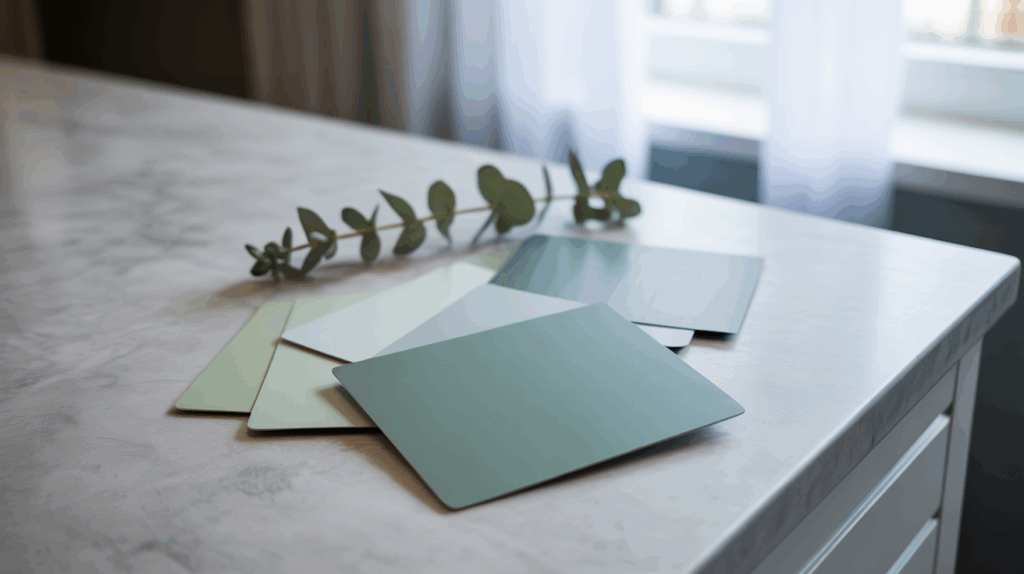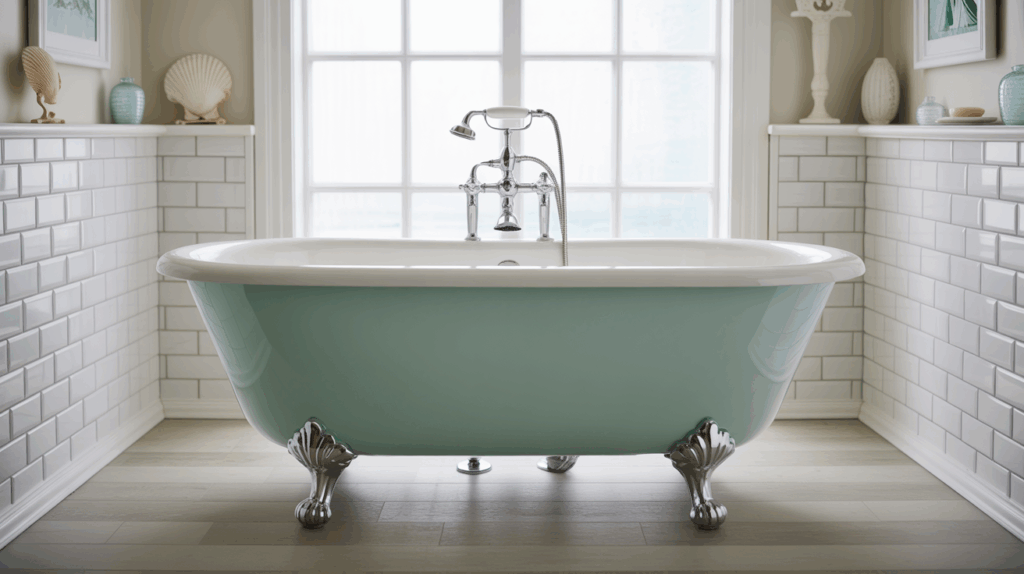Fresh Sage and Seafoam Green Bathroom Wall Colors to Try for a Serene Refresh
Table of Contents
Why Sage and Seafoam Green Are Trending for Bathroom Walls
In the ever-evolving world of home design, color trends come and go—but some tones continue to rise in popularity for their timeless and versatile appeal. Two shades that have captured the attention of designers and homeowners alike are sage green and seafoam green. These soft, nature-inspired hues are being embraced in bathrooms for good reason—they bring a fresh, calming energy that turns everyday routines into moments of quiet retreat.
Sage green offers a muted, earthy tone that pairs well with both rustic and contemporary styles. It adds just enough color without overwhelming the space. Seafoam green, on the other hand, has a subtle coastal vibe—light, airy, and a bit whimsical. Both shades are flexible enough to work with different materials like brass, wood, tile, and stone.
This article will explore why sage and seafoam are the perfect bathroom wall colors to try, how to pair them with complementary accents, and ways to choose between them depending on your bathroom’s style, size, and lighting. Whether you’re doing a complete renovation or just looking to refresh the walls with a new coat of paint, these greens are your go-to for creating a tranquil, rejuvenating space.
Understanding the Tone: What Makes Sage and Seafoam Ideal for Bathrooms
Sage and seafoam green are both rooted in nature, which is why they feel so restorative in a bathroom setting. Sage green leans toward a soft grey-green—a grounded, organic color that evokes foliage and herbs. Seafoam green, on the other hand, brings in a cooler blue undertone, offering a breezy, coastal feel reminiscent of ocean mist and seashells.
What sets these two hues apart from traditional bathroom whites or beiges is their ability to bring personality into the space while maintaining a sense of calm. They are light enough to reflect natural light and make the room feel open, but rich enough to provide a subtle pop of interest.
| Color | Undertone | Mood It Creates | Best For |
| Sage Green | Grey/Olive | Earthy, serene | Rustic, modern, boho styles |
| Seafoam Green | Blue/Teal | Fresh, coastal, airy | Beachy, cottage, vintage |
Both shades are ideal if you’re aiming for a spa-like retreat or a softly styled guest bathroom. They also provide an excellent canvas for layering in wood tones, white tile, gold fixtures, or botanical accents.

How to Pair Sage Green Bathroom Walls with Accents
Once you’ve settled on sage green as your wall color, the next step is selecting complementary materials and accessories to enhance the look. Sage pairs beautifully with natural textures and earthy neutrals, allowing you to build a bathroom that feels balanced and inviting.
Start with white or cream tile for a clean contrast. Add wood elements—like a floating vanity or rustic shelving—for warmth and texture. Metallic accents in brushed brass or matte black work well to provide contrast without overpowering the softness of sage.
| Accent Type | Ideal Choices | Design Tip |
| Metal Finishes | Brushed brass, matte black | Add with light fixtures or faucets |
| Wood Accents | Oak, walnut, bamboo | Use for vanities or open shelving |
| Textiles | White waffle weave, beige linen | Add cozy layers with texture |
| Decorative Touches | Dried florals, stone trays | Keep organic and natural |
Sage green walls also look striking when paired with vertical paneling, giving dimension and old-world charm. Whether you go sleek or cottage-inspired, sage offers adaptability with sophistication.

Seafoam Green Bathroom Walls for a Breezy, Coastal Feel
Seafoam green offers a fresh take on classic bathroom colors. With its cool, subtle blue tones, it evokes a sense of airiness and relaxation that is perfect for small spaces or bathrooms with limited natural light.
This hue works wonderfully with white or soft grey tile, polished chrome or nickel hardware, and marble countertops. Seafoam also plays well with nautical or vintage styles—think glass apothecary jars, distressed wooden mirrors, and rattan trays.
| Pairing Element | Best Choices | Styling Advice |
| Fixtures | Chrome, polished nickel | Adds brightness and reflection |
| Countertops | White quartz, Carrara marble | Keep finishes light and smooth |
| Flooring | White tile, soft grey vinyl | Avoid overly dark materials |
| Accessories | Coastal artwork, white towels | Keep to soft neutrals and textures |
Seafoam green is especially effective in bathrooms with a clawfoot tub or beadboard detailing, enhancing a vintage or seaside look without feeling themed or kitschy.

Choosing Between Sage and Seafoam Based on Bathroom Lighting
Lighting can dramatically alter how a color looks on the wall, and both sage and seafoam respond differently under various conditions. Before you commit, it’s worth sampling swatches on your actual bathroom wall and observing them at different times of day.
Sage green tends to thrive in bright bathrooms with good natural light, where its earthy richness is fully visible. Seafoam green, by contrast, works well in dimmer or windowless spaces because its cool tones reflect light and open up the room visually.
| Lighting Condition | Best Wall Color | Why It Works |
| North-Facing Bathroom | Seafoam Green | Brightens a cool, shadowy space |
| South-Facing Bathroom | Sage Green | Enhances natural warmth |
| Windowless Bathroom | Seafoam Green | Reflects light and feels airy |
| Skylight Bathroom | Either | Choose based on accent preference |
Always test paint samples under your bathroom’s specific lighting before making a final decision—what appears soft and calming in one home might look cold or muddy in another.
Incorporating Tile and Texture with Green Walls
Beyond paint alone, the interplay between color and texture is what makes a bathroom feel finished. Both sage and seafoam green work beautifully when contrasted with tile—whether it’s subway, zellige, mosaic, or hexagon.
To enhance the effect of your wall color, choose textured tiles in white, pale grey, or even a soft blush. Add vertical paneling or shiplap in green tones to create architectural interest. Mixing tile and painted walls also helps define zones—perfect for separating the vanity area from the shower.
| Texture or Tile | Best Use with Green Walls | Effect Achieved |
| White Subway Tile | Around vanity or bathtub | Clean and timeless contrast |
| Zellige or Handmade Tile | Accent walls or backsplash | Adds organic, artisanal texture |
| Vertical Wood Paneling | Lower wall section | Vintage and cozy charm |
| Mosaic or Hexagon Tile | Shower or floor | Pattern with subtle contrast |
When layering texture, the key is balance—let one element shine while others support it. A sage wall behind white zellige tile becomes a feature, while seafoam behind vertical paneling softens the room’s silhouette.
Designing with Intent: Style Pairings for Sage and Seafoam
Sage and seafoam may be similar in tone, but their style associations can guide how you complete the room. Sage leans more boho, rustic, or Scandinavian when styled with matte black or brass finishes, rattan, and natural wood. Seafoam, meanwhile, fits coastal, vintage, or romantic looks when paired with chrome, whitewashed furniture, and softer decor.
| Green Shade | Style Direction | Recommended Materials |
| Sage Green | Modern rustic, boho chic | Woven baskets, warm wood, linen |
| Seafoam Green | Coastal, vintage, classic | Marble, chrome, glass accents |
Pick a few key style markers—light fixture, vanity, mirror frame—and let your green shade inform the tone. The result will feel harmonious, layered, and thoughtfully curated.
Conclusion: A Tranquil Transformation with Just One Coat
Both sage and seafoam green bathroom wall colors offer a path to tranquility. Whether you’re leaning toward the earthy calm of sage or the breezy elegance of seafoam, these colors have the power to transform your bathroom into a soothing retreat.
With thoughtful styling, lighting awareness, and smart material pairings, your bathroom can reflect a timeless yet personal aesthetic. Green, in its softest forms, invites relaxation—bringing the essence of nature inside and making even the smallest spaces feel refreshed and intentional.

